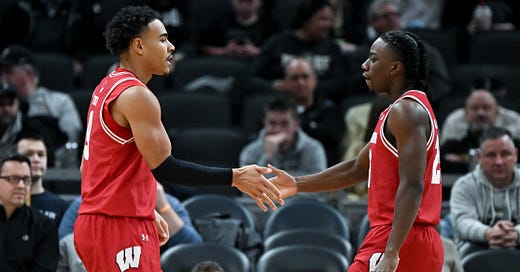Wisconsin basketball offense is elite, but Greg Gard needs more on defense
The Wisconsin basketball offense is surging with John Blackwell and John Tonje leading the charge, but can the Badgers' defense catch up?
If there’s one thing that’s become clear about Wisconsin basketball in 2024-25, it’s that this team can score—at a level the program hasn’t seen in decades when it comes to raw offensive production.
The Badgers have hit the 80-point mark in 13 games this season, a number tied for the most in a single season since 1970-71. And while in years past, an 80-point outing might have been an outlier, it’s now more of an expectation under Greg Gard’s evolving offensive approach.
Wisconsin’s offense has been firing on all cylinders for much of the season, averaging 82.5 points per game, shooting 47.2% from the field and 36.2% from three, with 15.3 assists a night fueling their attack.
For context, the 2014-15 Final Four team—recognized not just as Wisconsin’s offensive gold standard, but as the most efficient offense ever recorded by KenPom—averaged 71.9 points per game, assisted on 50.2% of its made baskets, and shot 35.7% from three.
This year’s group is ahead in nearly every raw offensive metric and has assisted on 55.6% of its made baskets, showcasing just how fluid and modernized the system has become with the right personnel.
That said, pace is a factor. Wisconsin currently sits 150th in tempo, the fastest of any team in the Bo Ryan or Greg Gard era. That’s a stark contrast from Coach Ryan's 2014-15 team, which ranked 345th in tempo but operated with historically elite efficiency.
That’s not to say this year’s team is better offensively than that group—because it’s not—but it does help show how Gard and his coaching staff have successfully adapted to a more modern offensive game.
A two-man scoring punch leading the charge
A big reason for the Wisconsin basketball team's offensive surge has been the consistent production of John Blackwell and John Tonje, forming one of the most dynamic 1-2 scoring duos in recent program history.
Tonje, a grad transfer pickup from the offseason, leads the team in scoring at 18.0 points per game and sits in the 91st percentile nationally in points per possession. Right behind him is sophomore John Blackwell, averaging 16.3 points per game and ranking in the 78th percentile, giving Wisconsin one of the most dynamic scoring duos in recent history.
“I think it's a byproduct of having a team that can really score,” Gard said. You can't zero in on one or two guys because then Steve [Crowl] will get something going, Nolan [Winter] will get stuff going.
“Then we bring some pop off the bench too, with [Carter] Gilmore and [Kamari] McGee. They're opportunistic.
Wisconsin’s balanced attack has helped create a free-flowing offense where players aren’t forced into specific roles. Notably, all five of the starters are averaging 10+ points per game, the first time the Badgers have had five players in double figures since their 2002-03 Big Ten title team.
“We don't come into it with a predetermined mindset that player A, B, or C has to get so many shots,” Gard continued. “You take what the defense gives you, and you try to put players in position of their strengths. And both Johns have done a good job.”
A shift in approach paying off
Beyond the individual scoring, Wisconsin has executed its revamped offensive philosophy at an elite level—particularly from beyond the arc.
When asked about Wisconsin’s recent three-point surge after the win over Nebraska, Coach Gard credited a mix of scheme adjustments, player development, and increased offensive fluidity.
“Well, I think it is an example and combination of all of the above,” Gard explained. “I think, schematically, how we designed this shift, so to speak, that is one area from when we look analytically, that we want to take advantage of. And, trade as many of those midrange twos in for threes or plays at the rim.
"It's partially the system, it's players, and we've got really good players that buy into it, and love playing in it… I think in years past we were maybe a little robotic and mechanical with it, and we've become more fluid. So, it becomes more organic, and then we throw in some wrinkles here and there to try to keep defenses off balance.
"I think it is some of all of those elements, I think it is an unselfish group that doesn't care who gets the credit, and it's a really talented team that has a lot of weapons that can shoot it. I mean, pretty much everybody we put on the floor is a legit threat from three."
Wisconsin's offense has proven time and time again that it can overwhelm opponents with an average of 82.5 points per game and a top-10 offensive efficiency ranking (No. 8). But as Gard has pointed out, the key to taking this team to the next level will be tightening up on the defensive end.
The Badgers recently cracked the top 50 in KenPom’s defensive efficiency rankings (No. 49), but Gard has set the goal of getting inside the top 25 to truly be among the country’s elite.
“I think we see offensively, we're a handful,” Gard said. “And when we get ourselves locked in defensively, we become a pretty complete team.”
Wisconsin’s offense is already proving it can be the program's identity. If the defense follows suit, this could be a dangerous team come March.
We appreciate you taking the time to read our work at BadgerNotes.com. Your support means the world to us and has helped us become a leading independent source for Wisconsin Badgers coverage.
You can also follow Site Publisher Dillon Graff at @DillonGraff on X.





Nice, I love seeing the Badgers light up the scoreboard! Do we know if there have been any similar changes to the defensive philosophy this year?